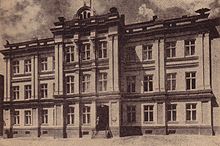Königsberg amber collection
The Königsberg amber collection in Königsberg (Prussia) comprised almost 100,000 pieces and was the world's most important and largest collection of amber . The part of the amber collection that was rescued to Göttingen contains numerous fossils as well as some Neolithic and early historical carvings, pearls, Bronze Age fibulae and important handicrafts from other epochs.
history
The Königsberg amber collection grew out of different parts. The first are from the late 18th century. The main part of the collection is made up of the holdings of the Stantien & Becker company . When they were acquired in 1899, Richard Klebs founded the Bernstein Museum. In addition, in 1906 the holdings of the Physico-Economic Society and various private collections were added. The undoubtedly most important part of the collection comes from Klebs and was purchased in 1926 for the Albertus University in Königsberg .
The Amber Museum was the only one of its kind in the world and contained pieces of amber of all colors and sizes. 120,000 inclusions and imprints of plants and animals bear witness to the period of the amber forests: conifer remains , but also coverings ; Insects , arachnids , crustaceans , earwigs , grasshoppers , termites , beetles and cicadas . The most precious inclusion was a lizard .
In November 1944, Karl Erich Andrée , the director of the amber collection, had the most valuable pieces in the collection packed in boxes and sent by courier to the Albertina's partner university, the Georg-August University in Göttingen . Together with other art treasures, books and collection material from the Albertina, they were stored in the Wittekind-Hildasglück potash plant . They survived the mine explosion in September 1945 and were confiscated by the British military government in 1946 . Until 1958 it was housed in the Kunstgutlager Schloss Celle . Since then, the Königsberg collection has been kept by today's Geoscientific Museum of the University of Göttingen , in trust for the Prussian Cultural Heritage Foundation . There are almost 18,000 pieces with excellently preserved plant and animal inclusions around 50 million years old . In addition, there are 2000 art and cultural objects from the Stone Age , the Middle and Northern European Bronze Age , Antiquity , the Middle Ages , the Renaissance and the modern era . Smaller parts of the collection were exhibited in special exhibitions in Duisburg (1977), Göttingen (1983, 2003, 2014), Bochum (1996), Lüneburg (1997) and Ribnitz-Damgarten (2006).
literature
- Karl Erich Andrée: About the "East Prussian gold", the amber, in general and the Klebs'schen amber collection and its importance for Königsberg and amber research in particular . Annual report of the Königsberg University Association 1926/27.
- Mike Reich, Joachim Reitner : From the Königsberg amber collection: Schwarzorter finds . Brochure. Göttingen 2014. Online version
Web links
- Amber museums and collections (ostpreussen.net)
- History of the Königsberg Amber Collection (GAU)
- Major manhunt for the Amber Room (Zeit Online)
Individual evidence
- ↑ Museums, collections and gardens of the University of Göttingen (2001)
- ↑ The recording of the Königsberg amber collection is making progress (Ostpreußenblatt 2000)
- ^ Herbert Meinhard Mühlpfordt : Königsberg from A to Z. A city lexicon , 2nd edition. Munich 1976.
- ↑ The Königsberg amber collection in danger (GAU)

